Page 95 of 420
CHILD-LOCKS
This system prevents the rear doors from being
opened from the inside.This device A fig. 75 can only be engaged with the
doors open:
❒position1-device engaged (door locked);
❒position2-device not engaged (door may be
opened from the inside).
The device remains on even if the doors are
unlocked electrically.
IMPORTANT The rear doors cannot be opened
from the inside when the child-lock system is
engaged.
WARNING
Always use this device when carr ying
children. After engaging the child lock on
both rear doors, check for effective engagement
by trying to open a door with the internal
handle.
fig. 75
F0Y0111
91GETTING TO
KNOW YOUR CARSAFETY
STARTING AND
DRIVING
WARNING LIGHTS
AND MESSAGES
IN AN EMERGENCY
SERVICING AND
MAINTENANCE
TECHNICAL
SPECIFICATIONS
INDEX
Page 96 of 420
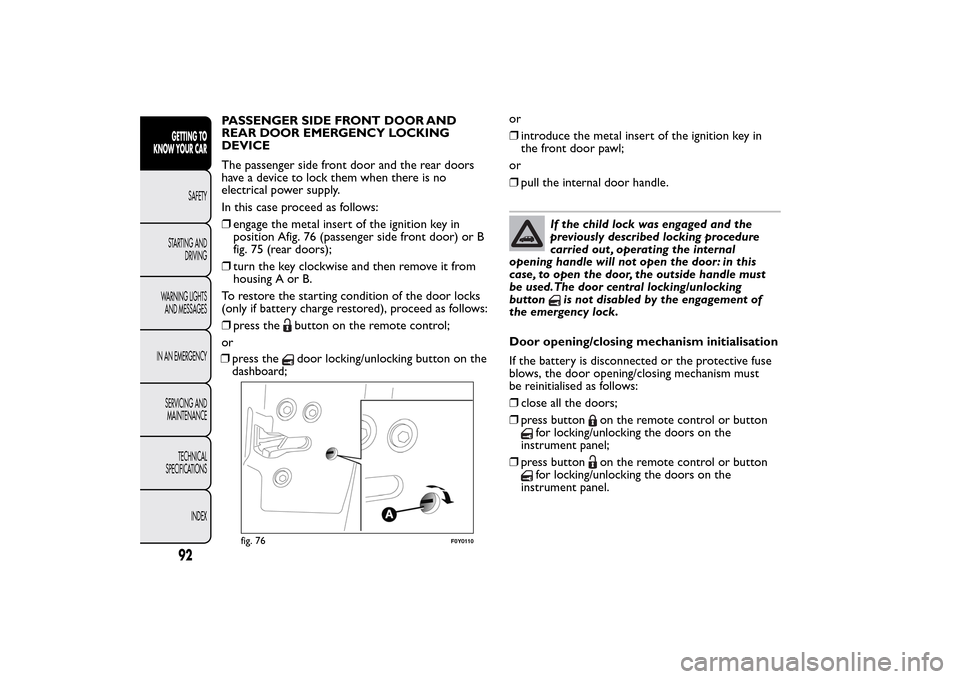
PASSENGER SIDE FRONT DOOR AND
REAR DOOR EMERGENCY LOCKING
DEVICE
The passenger side front door and the rear doors
have a device to lock them when there is no
electrical power supply.
In this case proceed as follows:
❒engage the metal insert of the ignition key in
position Afig. 76 (passenger side front door) or B
fig. 75 (rear doors);
❒turn the key clockwise and then remove it from
housing A or B.
To restore the starting condition of the door locks
(only if battery charge restored), proceed as follows:
❒press the
button on the remote control;
or
❒press thedoor locking/unlocking button on the
dashboard;or
❒introduce the metal insert of the ignition key in
the front door pawl;
or
❒pull the internal door handle.
If the child lock was engaged and the
previously described locking procedure
carried out , operating the internal
opening handle will not open the door: in this
case, to open the door, the outside handle must
be used.The door central locking/unlocking
button
is not disabled by the engagement of
the emergency lock.
Door opening/closing mechanism initialisation
If the battery is disconnected or the protective fuse
blows, the door opening/closing mechanism must
be reinitialised as follows:
❒close all the doors;
❒press button
on the remote control or button
for locking/unlocking the doors on the
instrument panel;
❒press button
on the remote control or button
for locking/unlocking the doors on the
instrument panel.
fig. 76
F0Y0110
92GETTING TO
KNOW YOUR CAR
SAFETY
STARTING AND
DRIVING
WARNING LIGHTS
AND MESSAGES
IN AN EMERGENCY
SERVICING AND
MAINTENANCE
TECHNICAL
SPECIFICATIONS
INDEX
Page 97 of 420
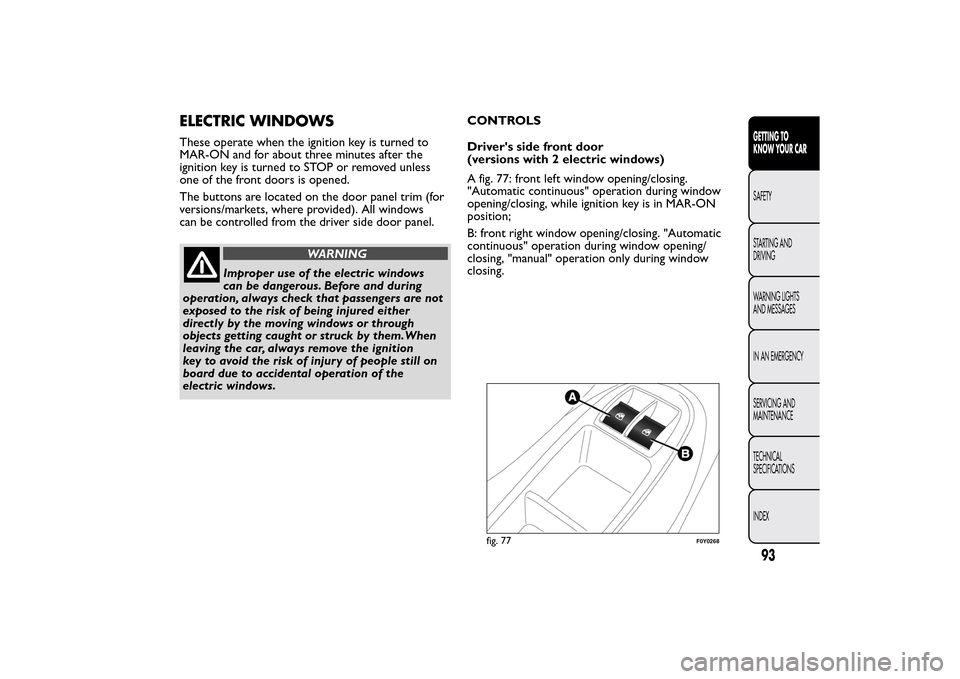
ELECTRIC WINDOWSThese operate when the ignition key is turned to
MAR-ON and for about three minutes after the
ignition key is turned to STOP or removed unless
one of the front doors is opened.
The buttons are located on the door panel trim (for
versions/markets, where provided). All windows
can be controlled from the driver side door panel.
WARNING
Improper use of the electric windows
can be dangerous. Before and during
operation, always check that passengers are not
exposed to the risk of being injured either
directly by the moving windows or through
objects getting caught or struck by them.When
leaving the car, always remove the ignition
key to avoid the risk of injury of people still on
board due to accidental operation of the
electric windows.CONTROLS
Driver's side front door
(versions with 2 electric windows)
A fig. 77: front left window opening/closing.
"Automatic continuous" operation during window
opening/closing, while ignition key is in MAR-ON
position;
B: front right window opening/closing. "Automatic
continuous" operation during window opening/
closing, "manual" operation only during window
closing.
fig. 77
F0Y0268
93GETTING TO
KNOW YOUR CARSAFETY
STARTING AND
DRIVING
WARNING LIGHTS
AND MESSAGES
IN AN EMERGENCY
SERVICING AND
MAINTENANCE
TECHNICAL
SPECIFICATIONS
INDEX
Page 98 of 420
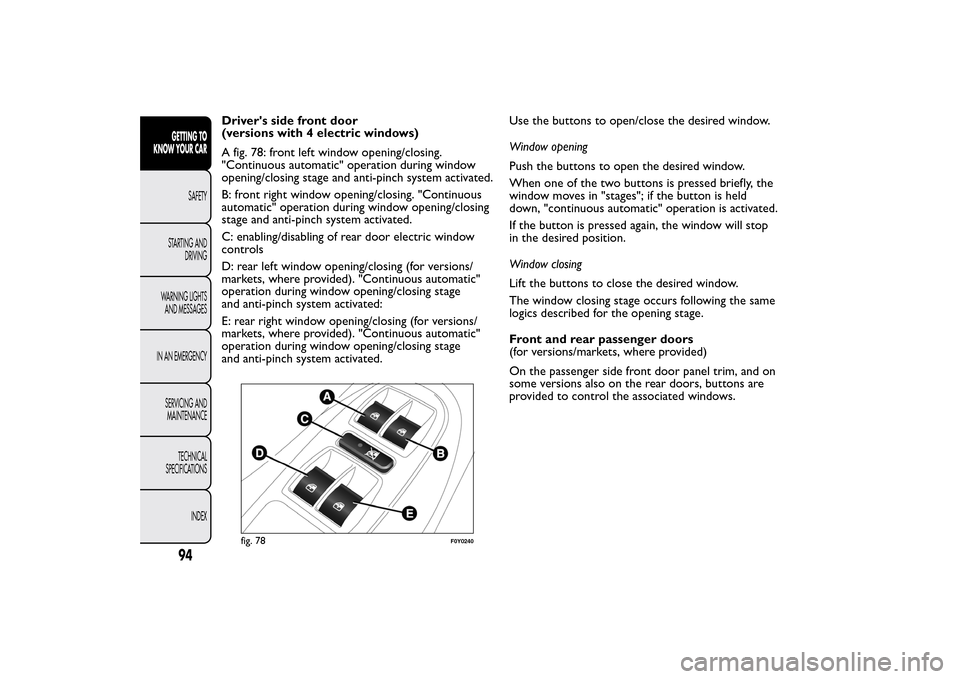
Driver's side front door
(versions with 4 electric windows)
A fig. 78: front left window opening/closing.
"Continuous automatic" operation during window
opening/closing stage and anti-pinch system activated.
B: front right window opening/closing. "Continuous
automatic" operation during window opening/closing
stage and anti-pinch system activated.
C: enabling/disabling of rear door electric window
controls
D: rear left window opening/closing (for versions/
markets, where provided). "Continuous automatic"
operation during window opening/closing stage
and anti-pinch system activated:
E: rear right window opening/closing (for versions/
markets, where provided). "Continuous automatic"
operation during window opening/closing stage
and anti-pinch system activated.Use the buttons to open/close the desired window.
Window opening
Push the buttons to open the desired window.
When one of the two buttons is pressed briefly, the
window moves in "stages"; if the button is held
down, "continuous automatic" operation is activated.
If the button is pressed again, the window will stop
in the desired position.
Window closing
Lift the buttons to close the desired window.
The window closing stage occurs following the same
logics described for the opening stage.
Front and rear passenger doors
(for versions/markets, where provided)
On the passenger side front door panel trim, and on
some versions also on the rear doors, buttons are
provided to control the associated windows.
fig. 78
F0Y0240
94GETTING TO
KNOW YOUR CAR
SAFETY
STARTING AND
DRIVING
WARNING LIGHTS
AND MESSAGES
IN AN EMERGENCY
SERVICING AND
MAINTENANCE
TECHNICAL
SPECIFICATIONS
INDEX
Page 99 of 420
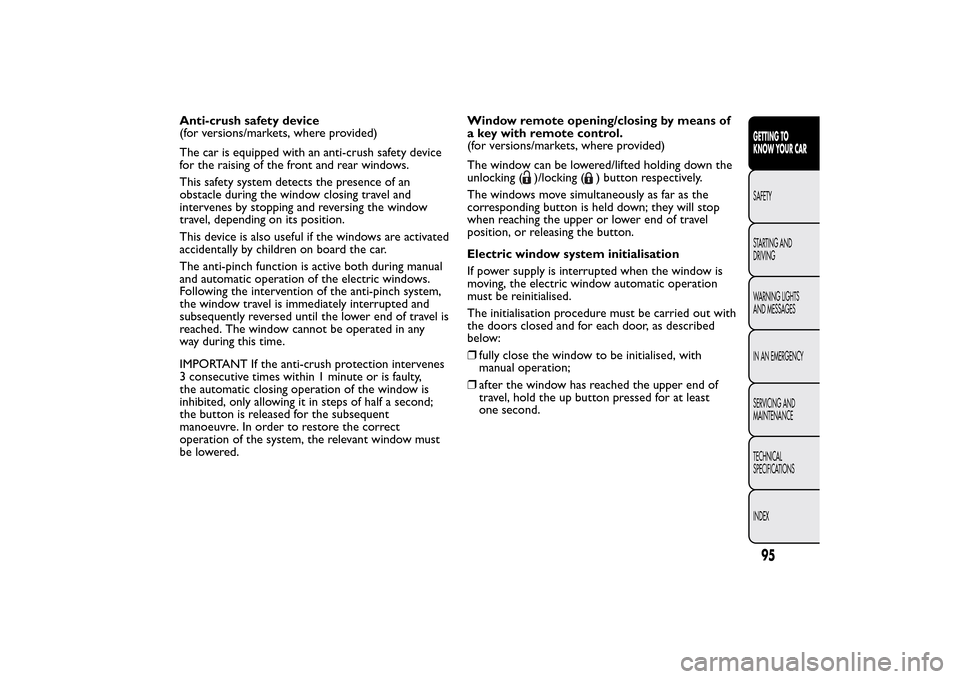
Anti-crush safety device
(for versions/markets, where provided)
The car is equipped with an anti-crush safety device
for the raising of the front and rear windows.
This safety system detects the presence of an
obstacle during the window closing travel and
intervenes by stopping and reversing the window
travel, depending on its position.
This device is also useful if the windows are activated
accidentally by children on board the car.
The anti-pinch function is active both during manual
and automatic operation of the electric windows.
Following the intervention of the anti-pinch system,
the window travel is immediately interrupted and
subsequently reversed until the lower end of travel is
reached. The window cannot be operated in any
way during this time.
IMPORTANT If the anti-crush protection intervenes
3 consecutive times within 1 minute or is faulty,
the automatic closing operation of the window is
inhibited, only allowing it in steps of half a second;
the button is released for the subsequent
manoeuvre. In order to restore the correct
operation of the system, the relevant window must
be lowered.Window remote opening/closing by means of
a key with remote control.
(for versions/markets, where provided)
The window can be lowered/lifted holding down the
unlocking (
)/locking (
) button respectively.
The windows move simultaneously as far as the
corresponding button is held down; they will stop
when reaching the upper or lower end of travel
position, or releasing the button.
Electric window system initialisation
If power supply is interrupted when the window is
moving, the electric window automatic operation
must be reinitialised.
The initialisation procedure must be carried out with
the doors closed and for each door, as described
below:
❒fully close the window to be initialised, with
manual operation;
❒after the window has reached the upper end of
travel, hold the up button pressed for at least
one second.
95GETTING TO
KNOW YOUR CARSAFETY
STARTING AND
DRIVING
WARNING LIGHTS
AND MESSAGES
IN AN EMERGENCY
SERVICING AND
MAINTENANCE
TECHNICAL
SPECIFICATIONS
INDEX
Page 100 of 420
MANUAL REAR WINDOW WINDERS
(for versions/markets, where provided)
To open and to close the window, use the relevant
handle fig. 79.
LUGGAGE COMPARTMENTLuggage compartment unlocking is electrically
operated and is deactivated when the car is
in motion.
OPENING
When unlocked, the luggage compartment can be
opened from outside the car using the electric
opening handle A fig. 80 located under the handle
until the unlocking click is heard or by pressing
the
button on the remote control.
The direction indicators will flash twice and an
internal light will switch on when the luggage
compartment is opened: the light switches off
automatically when the luggage compartment is
closed.
The light switches off automatically after a few
minutes if the luggage compartment is left open.
fig. 79
F0Y0267
fig. 80
F0Y0146
96GETTING TO
KNOW YOUR CAR
SAFETY
STARTING AND
DRIVING
WARNING LIGHTS
AND MESSAGES
IN AN EMERGENCY
SERVICING AND
MAINTENANCE
TECHNICAL
SPECIFICATIONS
INDEX
Page 101 of 420
WARNING
Be careful not to hit objects on the
storage shelf when you open the
tailgate.
Emergency opening from inside
Proceed as follows:
❒remove the rear head restraints and completely
fold back the seats (see the paragraph "Extending
the luggage compartment");
❒take the screwdriver provided from the tool box
or the Fix&Go Automatic container, depending
on the version;❒use the screwdriver to remove the yellow tab A
fig. 81;
❒then insert the screwdriver in housing B fig. 82 in
order to activate the luggage compartment release
tab.
fig. 81
F0Y0172
fig. 82
F0Y0173
97GETTING TO
KNOW YOUR CARSAFETY
STARTING AND
DRIVING
WARNING LIGHTS
AND MESSAGES
IN AN EMERGENCY
SERVICING AND
MAINTENANCE
TECHNICAL
SPECIFICATIONS
INDEX
Page 102 of 420
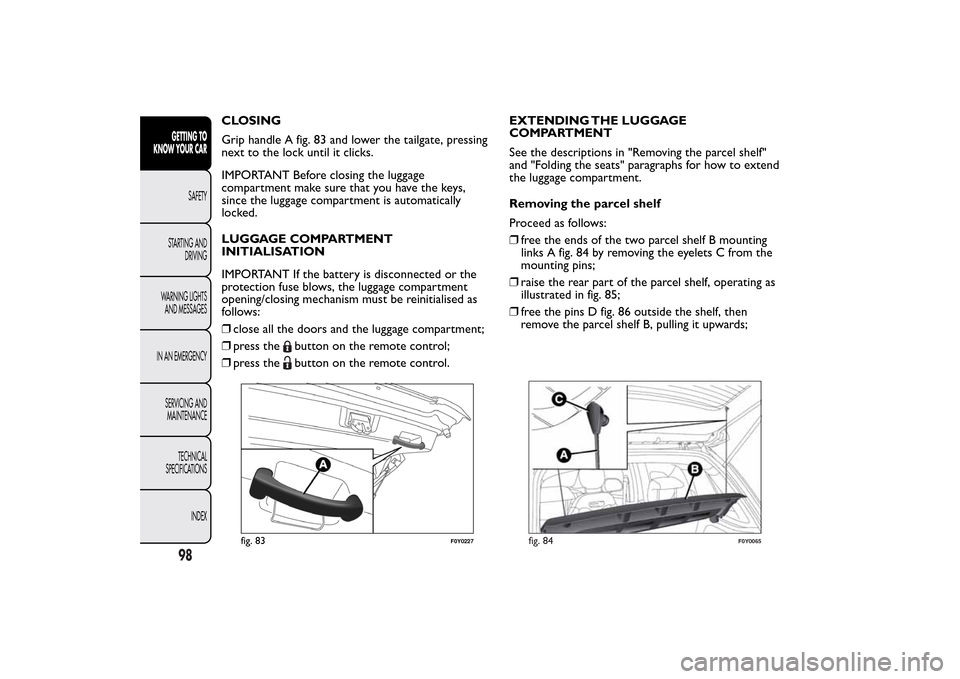
CLOSING
Grip handle A fig. 83 and lower the tailgate, pressing
next to the lock until it clicks.
IMPORTANT Before closing the luggage
compartment make sure that you have the keys,
since the luggage compartment is automatically
locked.
LUGGAGE COMPARTMENT
INITIALISATION
IMPORTANT If the battery is disconnected or the
protection fuse blows, the luggage compartment
opening/closing mechanism must be reinitialised as
follows:
❒close all the doors and the luggage compartment;
❒press the
button on the remote control;
❒press thebutton on the remote control.EXTENDING THE LUGGAGE
COMPARTMENT
See the descriptions in "Removing the parcel shelf"
and "Folding the seats" paragraphs for how to extend
the luggage compartment.
Removing the parcel shelf
Proceed as follows:
❒free the ends of the two parcel shelf B mounting
links A fig. 84 by removing the eyelets C from the
mounting pins;
❒raise the rear part of the parcel shelf, operating as
illustrated in fig. 85;
❒free the pins D fig. 86 outside the shelf, then
remove the parcel shelf B, pulling it upwards;
fig. 83
F0Y0227
fig. 84
F0Y0065
98GETTING TO
KNOW YOUR CAR
SAFETY
STARTING AND
DRIVING
WARNING LIGHTS
AND MESSAGES
IN AN EMERGENCY
SERVICING AND
MAINTENANCE
TECHNICAL
SPECIFICATIONS
INDEX